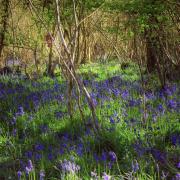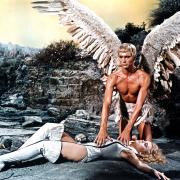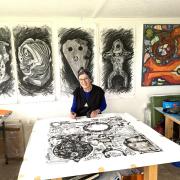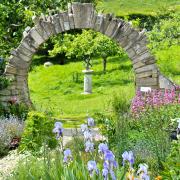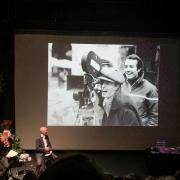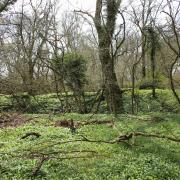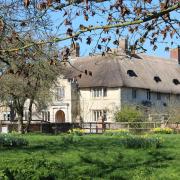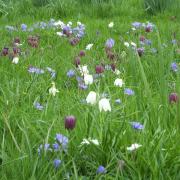Paul Watts tells the story of Alan Carter, a man of prodigious talent who worked with some of the greatest dancers in the world and transformed his passion for dance into art
Choreographics
Paul Watts tells the story of Alan Carter, a man of prodigious talent who worked with some of the greatest dancers in the world and transformed his passion for dance into art
When I was first shown Alan Carter’s paintings I was bowled over; they were extraordinary pieces of fluidity and beauty that captured the movement of dance in a unique and dramatic way. However, talking with his widow, Julia, I discovered that Alan was a man of prodigious talent, wit and humour who worked with some of the world’s greatest dancers.
The Dancer Born in 1920, Alan was a thin and weakly child who, on the advice of a doctor, started dancing classes in Tunbridge Wells. Passing all his Royal Academy of Dancing exams with honours, he left school to pursue an artistic education. At 14, after the tragic death of his father, Alan and his mother moved to London, where he attended the Chelsea Art School once a week; at that time Henry Moore was there. Alan also studied dance and acting at the Italia Conti School, where the famous dancers Alicia Markova and Anton Dolin were often present. Alan had private ballet lessons with the Russian Princess Serafina Astafieva at the Pheasantry in Kings Road, where he and Peggy Hookham (later to become Margot Fonteyn) shared many classes, becoming good friends. The two mothers would sit on the coal box to watch their respective offspring.Alan’s greatest influence was the famous Russian �migr� Nicholai Legat, who ran his studio in Colet Gardens (next to the Royal Ballet School). Here Alan, mixing with all the famous ballet dancers of that period, found his master – Legat was a teacher with a great understanding of the art of dance and the flow of movement; he was also an accomplished caricature artist. After Legat died, Alan was accepted by Ninette de Valois into the Vic Wells Ballet (now the Royal Ballet) in 1937 and a year later performed his first principal role as Harlequin, specially choreographed for him by Frederick Ashton in Harlequin in the Street. Alan enjoyed dancing various roles before being enlisted into the RAF for war service. When he came out in 1946, he returned to the Sadler’s Wells Theatre as principal dancer and produced his first choreography The Catch, which became a show-stopper. Later on he danced and directed the St James’s Ballet Company, formed by the Arts Council of Great Britain, touring theatre-less towns in the UK, where their performances were much appreciated by coal miners and their families.Alan was also very much involved with the classic ballet film The Red Shoes as assistant to Robert Helpmann and was Ballet Master for all the dancing, as well as dancing the role of Benno in the Swan Lake scene. He subsequently became Ballet Master for several films, including The Tales of Hoffmann, Invitation to the Dance directed by Gene Kelly, and choreographed the film The Man Who Loved Redheads, working again with Moira Shearer. He also choreographed the London Palladium Show with Norman Wisdom and other stars.
The ArtistAlan was a true Renaissance Man with a lifelong interest in music, composing, writing, dance, sketching and painting. In 1954 he was invited to become Ballet Director to the Munich Staatsoper and over the next five years, as well as producing and choreographing ballets, he designed d�cor and costumes and held his first art exhibition at the Theatre Art Museum. It was during this Munich period that Alan created his first ‘dance’ pictures – trying to portray a sense of movement that a dancer feels when given steps to perform. He subsequently returned to the Royal Ballet to guest teach and work with the touring company, by then his directorship of ballet companies included Wuppertal, Bordeaux, Istanbul, Finland, Norway, Iceland and Tehran. It was while Alan was in Wuppertal that these dance pictures began to take shape and developed into extraordinary compositions he called ‘Choreographics’. When preparing choreography for a ballet, he would sketch the movement he wished the dancers to emulate – once they saw them the dancers immediately comprehended what was required. One of these dancers was a ballerina called Julia and a special partnership grew between them, resulting in marriage. They subsequently settled in Bournemouth in the late ’70s. Over the ensuing years, as well as bringing up a family, Alan and Julia took over the Wessex School of Dancing, producing shows and running courses.During their 45 years together Julia saw her husband’s highly original style of depicting movement in dance develop and she helped organise exhibitions of his work. Since his death last year she has been left with a lasting legacy of his tremendous artistic talent in the form of his paintings, ranging from choreographics to landscapes and caricatures. Some of these pictures hang on the walls, but many are in folders, not seeing the light of day. It was from a chance encounter through a mutual friend that Julia and I met. As proprietor of The ARThouse Gallery in Bournemouth, I was intrigued to see Alan’s work and a meeting was arranged for me to view it. Having no idea what to expect, I was bowled over by his pieces and decided to stage a one-man exhibition of Alan’s ‘Choreographics’, giving the public a chance to share the extraordinary talent of this ‘Renaissance Man’.
Alan Carter’s ‘Choreographics’ is at The ARThouse Gallery, Bourne Avenue, The Square, Bournemouth BH2 6DP,from 5-25 July 2010. Further information: call 01202 555131 or visit thearthousegallery.org.Discover more exhibitions at dorset.greatbritishlife.co.uk



